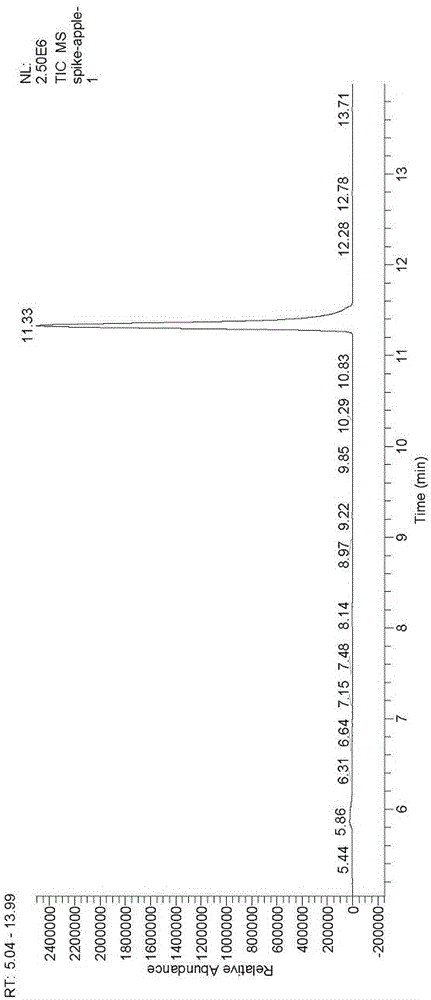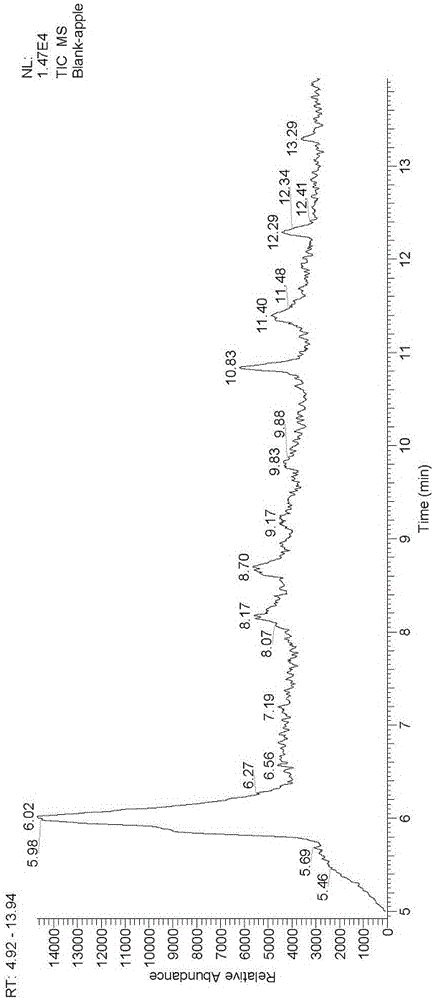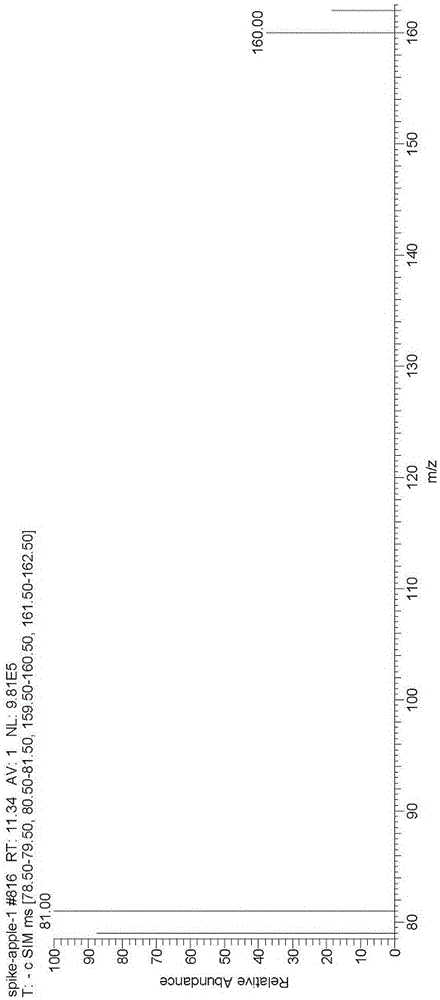Method for measuring dibromochloropropane residues in fruits and vegetables by GC-NCI-MS
A GC-NCI-MS, dibromochloropropane technology, applied in the field of pesticide residue detection, can solve the problems of cumbersome detection steps, large solvent consumption, poor reproducibility, etc., and achieves strong selectivity, good reproducibility and toxicity. small effect
- Summary
- Abstract
- Description
- Claims
- Application Information
AI Technical Summary
Problems solved by technology
Method used
Image
Examples
Embodiment 1
[0026] Embodiment 1: take apple as example below, illustrate the assay method of dibromochloropropane residue, comprise the steps:
[0027] (1) Sample pretreatment
[0028] Weigh 15g of crushed and well-mixed apples, put them in a 100mL plastic centrifuge tube, add 15mL of 0.1% acetic acid / acetonitrile solution, 6.0g of anhydrous magnesium sulfate, and 1.5g of anhydrous sodium acetate, stir well with a glass rod, and place in Homogenize at high speed on a homogenizer for 2 minutes, 10000r / min, and centrifuge at 4°C for 10 minutes;
[0029] Take 10mL of the supernatant in a 250mL rotary evaporator, and evaporate until nearly dry, accurately add 2mL of acetonitrile to dissolve the residue, vortex mix at 1400r / min for 2min, transfer the solution into a centrifuge tube filled with 150mgPSA, 200mgC18 and 100ul toluene, 1400r / min Vortex for 2 minutes, purify the solution at 4000r / min, centrifuge for 10 minutes and filter with a 0.45um filter membrane for GC-NCI-MS analysis.
[003...
Embodiment 2
[0048] Embodiment 2, taking frozen spinach as an example, illustrates the assay method of dibromochloropropane residue, comprising the steps:
[0049] (1) Sample pretreatment
[0050] Weigh 15g of crushed and well-mixed frozen spinach, put it in a 100mL plastic centrifuge tube, add 15mL of 0.1% acetic acid / acetonitrile solution, 6.0g of anhydrous magnesium sulfate, and 1.5g of anhydrous sodium acetate, stir well with a glass rod, Homogenize on a homogenizer at high speed for 2min, 10000r / min, centrifuge at 4°C for 10min, take 10mL of the supernatant in a 250mL rotary evaporator, rotary evaporate until nearly dry, accurately add 2mL of acetonitrile to dissolve the residue, and vortex at 1400r / min for 2min , the solution was transferred into a centrifuge tube filled with 150mgPSA, 200mgC18 and 100uL toluene, and vortexed at 1400r / min for 2min. The purified solution was centrifuged at 4000r / min for 10min and then filtered with a 0.45um filter membrane for GC-NCI-MS analysis.
...
PUM
| Property | Measurement | Unit |
|---|---|---|
| recovery rate | aaaaa | aaaaa |
| recovery rate | aaaaa | aaaaa |
Abstract
Description
Claims
Application Information
 Login to View More
Login to View More - R&D
- Intellectual Property
- Life Sciences
- Materials
- Tech Scout
- Unparalleled Data Quality
- Higher Quality Content
- 60% Fewer Hallucinations
Browse by: Latest US Patents, China's latest patents, Technical Efficacy Thesaurus, Application Domain, Technology Topic, Popular Technical Reports.
© 2025 PatSnap. All rights reserved.Legal|Privacy policy|Modern Slavery Act Transparency Statement|Sitemap|About US| Contact US: help@patsnap.com



